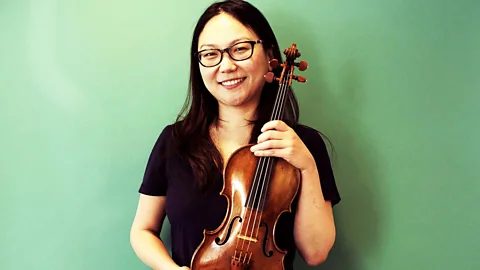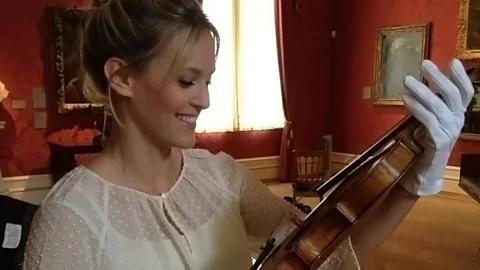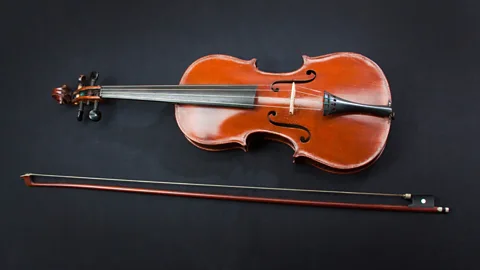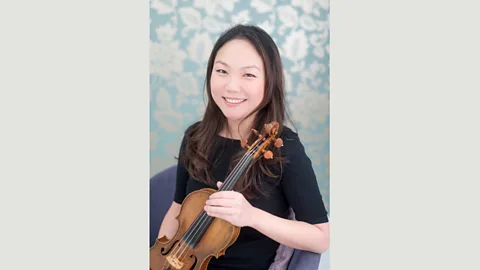The tragic tale of a prodigy’s stolen violin

 BBC
BBCMin Kym was a violin prodigy on the cusp of a glittering career when her treasured instrument was stolen. Clemency Burton-Hill explains what happened next.
In 2013, I was given the opportunity of a lifetime: to make a film about Antonio Stradivari, the most revered violin maker in history. I was able to hold and examine some of the most prized musical instruments ever created, and talk to leading experts in my quest to try and solve the fundamental enigma of his genius.
And then, in a moment I’ll never forget, I was actually allowed to play a Stradivarius: his earliest known instrument, the Serdet, which dates from 1666. It probably sounds dramatic, but suddenly I understood why Stradivarius is Stradivarius. I knew that if I could play this violin every day for the rest of my life, it still wouldn’t be enough. To have to put it back in its case after the cameras stopped rolling was a wrench.
Like most violinists, I will never have the chance to own a ‘Strad’, as they are lovingly known in violin circles. I was lucky to even get the opportunity to touch one. But Min Kym is not most violinists: a musical prodigy who, at 7, became the youngest person ever to be accepted to London’s famous Purcell School of Music and four years later won the prestigious International Mozart Competition, she was on track to become one of the handful of classical soloists who hit the big time. But she needed the right instrument.

Having searched for years, aged 21 she was by chance presented with a certain violin that was for sale. Made in 1696, it needed extensive restoration (and upkeep that would cost £5000 per year), but she knew - at once - that she did not have an option not to own this violin. She had found her soulmate for life.
“The instant I drew the first breath with my bow, I knew,” she writes in her powerful memoir Gone: A Life Unstrung. “It felt as if 300 years ago Stradivarius had held his hands over a length of wood and fashioned this violin just for me. It was love at first sight.”
Kym remortgaged her flat and bought the violin for £450,000 ($580,000). If this seems like an astronomical amount of money, it was in fact a steal in Stradivarius : the violin’s actual worth was closer to £1.2m ($1.5m) and these instruments are so precious that their value only ever goes up. It was in any case worth every penny to Kym. In the decade that followed, her conviction that this was the relationship she had been waiting for all her life was vindicated: her career skyrocketed, she performed all over the world to international acclaim, and landed a major record deal. She was on the cusp of releasing an album of the Brahms violin concerto. More importantly, through this violin, she felt she had found herself.
 Alamy
AlamyThen tragedy struck. One rainy November evening, her Strad was whisked away by professional thieves at a branch of Pret a Manger in London’s Euston Station. Time seemed to stop, she recalls; and then her life as she knew it did indeed stop. Kym spiralled into a clinical depression so intense that she could barely get out of bed. She could hardly function. She certainly couldn’t make music. The prospect of holding another violin - even another Strad - was abhorrent.
‘The Euston Strad’
To most of us, it might sound strange, even absurd, that Kym should see not just her career but her entire sense of self as dependent on a particular piece of wood and strings. In the manner of those who say things like ‘there are plenty more fish in the sea’ after a break-up, time and again after the theft she heard variations of ‘you’ll get over it’. One dealer, trying to be kind and to offer a practical solution, said: “yours is not the only violin in the world.”
 Alamy
AlamyBut one of the most powerful aspects of Kym’s unique and gripping memoir is how she sheds light on the deeply personal relationship that great classical artists have with their instruments, many of which will survive for centuries, long outlasting their owners and containing within them ghostly echoes and secrets from the past. She conveys the precision yet mystery of how this particular 17th-Century instrument enabled her own millennial voice and personality to be fully realised, despite being 300 years old. In short, then, this violin was the only one in the world, for her. “If it had been my child that had been stolen,” she wonders, “would people have expected me to accept another one?”
 Penguin Random House
Penguin Random HouseMost Strads are given sobriquets or code names based on previous owners, such as the ‘Ole Bull’, the ‘ex-Captain Saville’, or the ‘Gibson, ex-Huberman’ currently owned by Joshua Bell. It is heartbreaking that Kym’s former violin is now known as the ‘Euston Strad’. In a sequence of events worthy of a thriller, the stolen violin was eventually recovered, three years later, and the thieves convicted. But in a dramatic and gut-wrenching twist, Kym was unable to keep it.
Writing the memoir has been an act of catharsis. She has found, through words, a new sense of self and purpose. She has even begun a tentative relationship with a new violin, and has now recorded a beautiful album to accompany the memoir. The thieves who stole her Strad may have ruined Min Kym’s life, but she has not allowed them to steal her voice.
Min Kym will be talking to Clemency Burton-Hill on 3 June at the Hay Festival.
If you would like to comment on this story or anything else you have seen on BBC Culture, head over to our Facebook page or message us on Twitter.
And if you liked this story, sign up for the weekly bbc.com features newsletter, called “If You Only Read 6 Things This Week”. A handpicked selection of stories from BBC Future, Earth, Culture, Capital, Travel and Autos, delivered to your inbox every Friday.
